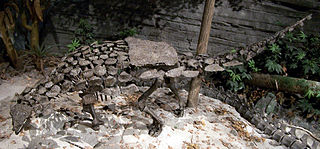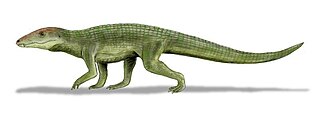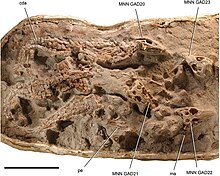
Nodosauridae is a family of ankylosaurian dinosaurs, from the Late Jurassic to the Late Cretaceous period in what is now North America, South America, Europe, and Asia.
Brasileosaurus is a genus of notosuchid notosuchian from the Late Cretaceous Adamantina Formation of Brazil. The type species is B. pachecoi, discovered by the Brazilian Eng. Joviano Pacheco and described by the prolific German paleontologist Friedrich von Huene in 1931.

Isisaurus is a genus of titanosaurian dinosaur from the Late Cretaceous Lameta Formation of India and Pab Formation of Pakistan. The genus contains a single species, Isisaurus colberti.

Simosuchus is an extinct genus of notosuchian crocodyliforms from the Late Cretaceous of Madagascar. It is named for its unusually short skull. Fully grown individuals were about 0.75 metres (2.5 ft) in length. The type species is Simosuchus clarki, found from the Maevarano Formation in Mahajanga Province, although one isolated multicuspid tooth of this genus was discovered in Kallamedu Formation of India.

Ceratosauridae is an extinct family of theropod dinosaurs belonging to the infraorder Ceratosauria. The family's type genus, Ceratosaurus, was first found in Jurassic rocks from North America. Ceratosauridae is made up of the genera Ceratosaurus, found in North America, Tanzania, and Portugal, and Genyodectes, from the Early Cretaceous of Argentina. Unnamed probable ceratosaurids are known from limited material in the Middle Jurassic of Madagascar, the Late Jurassic of Switzerland, the Late Jurassic of Tanzania, and the Late Jurassic or possibly Early Cretaceous of Uruguay.

Uruguaysuchus is an extinct genus of crocodyliforms from the Late Cretaceous Guichón Formation of Uruguay. It was related to Simosuchus and Malawisuchus. It was of small to moderate size reaching an estimated length of 120 centimetres (3.9 ft).

Araripesuchus is a genus of extinct crocodyliform that existed during the Cretaceous period of the late Mesozoic era some 125 to 66 million years ago. Six species of Araripesuchus are currently known. They are generally considered to be notosuchians, characterized by their varied teeth types and distinct skull elements. This genus consists of six species: A. buitreraensis, discovered in Argentina, A. wegeneri, discovered in Cameroon and Niger, A. rattoides, discovered in Niger, A. tsangatsangana, discovered in Madagascar, A. gomesii, discovered in Brazil and another species discovered in Argentina, A. patagonicus. It has been argued that the phylogenetic position of this genus is uncertain, and that taxonomic revision is required.
The Guichón Formation is a Late Cretaceous geologic formation of the Paysandú Group in Uruguay. Dinosaur remains are among the fossils that have been recovered from the formation.
Candidodontidae is a family of notosuchian crocodyliforms. It was originally used in 2002 as a name for a clade that includes the genera Araripesuchus, Candidodon, and Malawisuchus. Later in 2004 the family was formally defined as a node-based taxon including Candidodon itapecuruense and Mariliasuchus amarali. A 2009 study redefined Candidodontidae as a stem-based taxon which included Candidodon, Malawisuchus, and possibly Mariliasuchus.

Aristonectinae is a subfamily of plesiosaurs in the family Elasmosauridae. It includes the Late Cretaceous plesiosaurs Aristonectes and Kaiwhekea, traditionally grouped with the Late Jurassic Tatenectes and Kimmerosaurus in the family Aristonectidae. They are distinguished by the fact that they have a very enlarged skull compared to the width of the body, a moderately short neck and more than 25 teeth in the maxilla.
Yaminuechelys is an extinct genus of chelid turtle from Argentina and the Dorotea Formation of Chile. The genus first appeared during the Late Cretaceous and became extinct during the Late Paleocene.
The fauna of Uruguay is a part of the wildlife of Uruguay.
Tacuarembemys is an extinct genus of continental turtle from South America. It contains a single species, T. kusterae. The genus was described based on the external mold of a carapace and associated shell bone fragments found near the city of Tacuarembó, Uruguay. This fossil was found on the Tacuarembó Formation, whose estimated age ranges from late Jurassic to earliest Cretaceous.

Yamanasaurus is an extinct genus of saltasaurine titanosaur dinosaur from the Río Playas Formation of Ecuador, which dates to the Maastrichtian epoch of the Cretaceous period. The type and only species is Yamanasaurus lojaensis. It is the first non-avian dinosaur described from Ecuador.

The Dorotea Formation is a geological formation in the Río de Las Chinas Valley of the Magallanes Basin in Patagonian Chile whose strata date back to the Campanian to Maastrichtian of the Late Cretaceous.
The Tacuarembó Formation is a Late Jurassic (Kimmeridgian) geologic formation of the eponymous department in northern Uruguay. The fluvial to lacustrine sandstones, siltstones and mudstones preserve ichnofossils, turtles, crocodylomorphs, fish and invertebrates.

Arackar is an extinct genus of lithostrotian sauropod, possibly part of the Saltasauridae, discovered in the Hornitos Formation of Atacama Province, Chile. The genus contains a single species, Arackar licanantay, described by Rubilar-Rogers et al. in 2021.
Tacuadactylus is a genus of ctenochasmatid pterosaur from the Late Jurassic of Uruguay.

Saltasauroidea is a superfamily of titanosaurs named by França and colleagues in 2016 based on their phylogenetic results, for a clade uniting Aeolosaurini and Saltasauridae, as well as the intermediate genera Baurutitan, Diamantinasaurus and Isisaurus. The group was not defined or discussed in the text, but was supported by Carballido and colleagues in 2022 as a useful designation for subdividing titanosaurs. As there was no discussion about the intentions for the clade, Carballido gave it the definition of all taxa closer to Saltasaurus than Patagotitan, encompassing half of Eutitanosauria as the sister taxon to the inversely defined Colossosauria. Carballido et al. placed Nemegtosauridae and Saltasauridae within the group, though they had Aeolosaurini within Colossosauria. The informal cladogram of titanosaur relationships they proposed is shown below.
Patagopelta is an extinct genus of ankylosaurian dinosaur from the Late Cretaceous Allen Formation of Argentina. The genus contains a single species, P. cristata, known from a partial skeleton. While originally described as a nodosaurine, later discoveries provided support for parankylosaurian affinities for the taxon. Patagopelta is a very small ankylosaur, comparable in size to the dwarf nodosaurid Struthiosaurus, about 2 m (6.6 ft) long.












